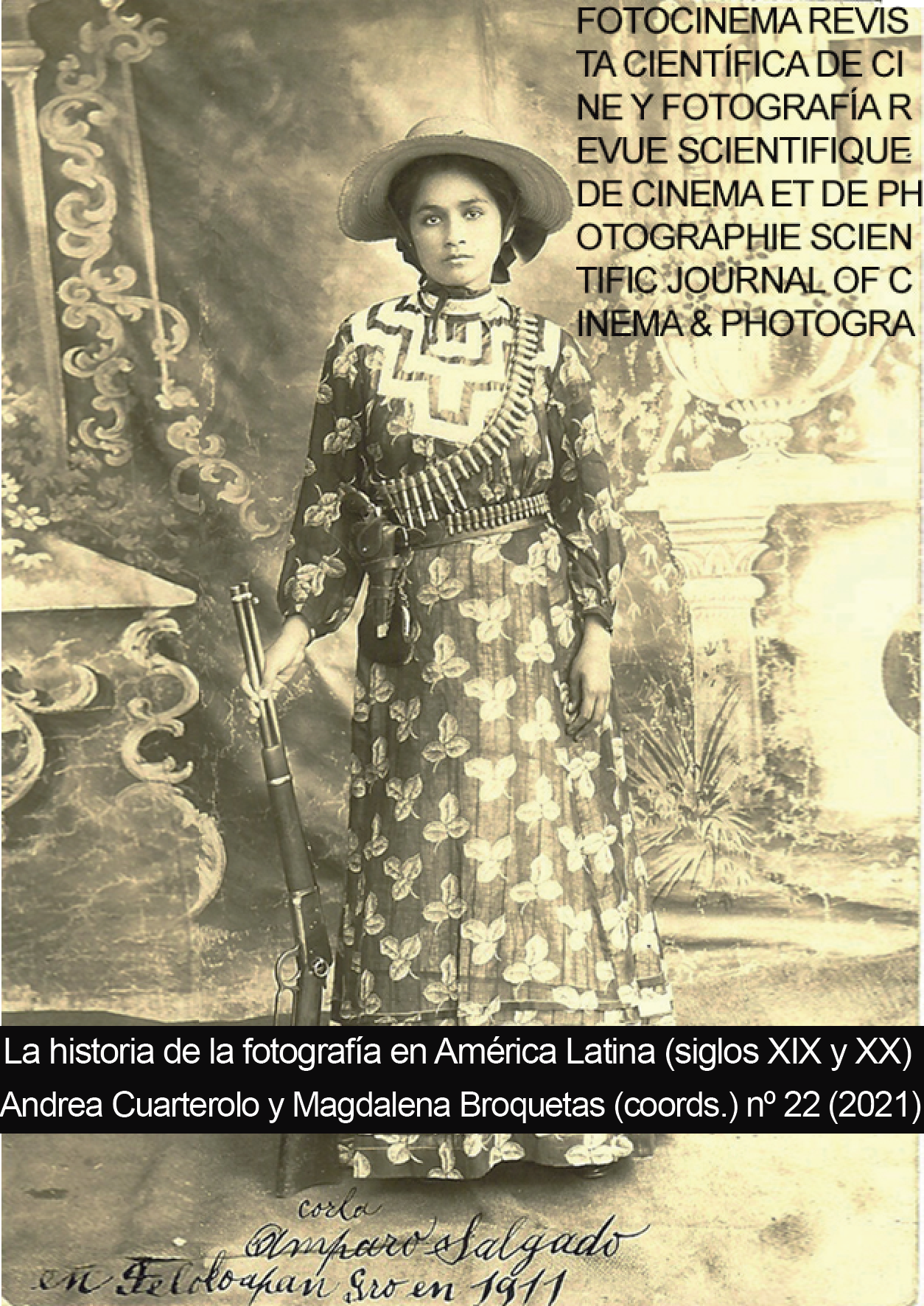Experiences and photographic experimentation in Argentina in the seventies
DOI:
https://doi.org/10.24310/Fotocinema.2021.vi22.11704Keywords:
Argentine photography, avant-garde, experimentation, technic individuation, photographic materiality, photographic exhibitionsAbstract
Despite the fact that photographic experimentalism in Latin America, and particularly in Argentina, has been constantly displaced from the lines of historical and socio-cultural research on the arts and visual culture, in recent years this aesthetic phenomenon has acquired greater relevance in research on the medium. In this article I propose to analyze the discourses and practices on the experimentation of technical images in the Argentina of the seventies. During this decade, exhibitions of the photographic medium were held that showed the interest of several photographic groups in exploring the material possibilities of the photographic image in the key of an aesthetic anti-conventionalism. To carry out this work, we will first investigate the debates on photographic experimentalism, understood from various perspectives as a specific understanding of the medium, and then determine the links between these conceptions of photography and the cases of the Manifesto of the Experimental Photographic Group, the direct shots of the Beta Group presented in Lirolay and the photograms exhibited in Visual Experiences with Photographic Media in Odin’s Gallery. Finally, we will examine the place of the technique as a material substrate that made possible to set the photographic experiments in this context.
Downloads
Metrics
References
Alonso, R. (2018). La unión hace la fuerza. Buenos Aires: Fundación Alfonso y Luz Castillo.
Anónimo. (1974). Fotografía experimental. Artesanía sin límites de búsqueda, Fotografía Universal, año X, (119), 19-20.
Anónimo. (1970). Grupo “Beta”: fotografías en Lirolay, Fotografía Universal, año VIII, (80), 25.
Anónimo. (1971). Foto y expresión, Fotografía Universal, año IX, (87), 20.
Benjamin, W. (2011) 1936. La obra de arte en la época de su reproductibilidad técnica y otros escritos. Buenos Aires: Godot.
Flusser, V. 2014. Para una filosofía de la fotografía. Buenos Aires: La Marca.
Foster, H. (2001). El retorno de lo real. La vanguardia a finales de siglo. Madrid: Akal.
Gamarnik, C. (2016). La fotografía de prensa en Argentina durante la década del 1960: modernización e internacionalización del periodismo gráfico, Revista Photo & Documento, (2), s/p.
Giglietti, N. (2014). Espacios para lo fotográfico. La Plata y Buenos Aires 1980-1991, Boletín de Arte, (14), 32-39.
Giunta, A. 2008. Vanguardia, internacionalismo y política: arte argentina en los años sesenta. Buenos Aires: Siglo XXI.
González-Flores, L. (2018). La fotografía ha muerto, ¡viva la fotografía! México: Herder.
Herrera, M. J. (2014). 1969-1976 Conceptualismo, realismo, identidad colectiva y proyecto nacional. En Cien años de arte argentino, pp. 185-220 Buenos Aires: Biblos.
Kanev, V. (1998). El manifiesto como género. Manifiestos independentistas y vanguardista, América: Cahiers du CRICCAL, (21), 11-18.
Krauss, R. (2002). Notas sobre la fotografía y el simulacro. En Lo fotográfico: por una teoría de los desplazamientos, pp. 216-231. Barcelona: Gustavo Gili.
Mangone, C. & Warley, J. (1994). El manifiesto. Un género entre el arte y la política. Buenos Aires: Biblos.
Maynard, P. (1997). The Engine of Visualization. Thinking through Photography. Ithaca: Cornell University Press.
Otero, M. A. (1971). CEV, Fotografía Universal, año X, (80), 30-35.
Pérez Fernández, S. (2011). Apuntes sobre fotografía argentina a fin de siglo: hacia la construcción de un mercado, Artículos de investigación sobre fotografía. Montevideo: CMDF, 7-47.
Poggioli, R. (1968). The Theory of the Avant-Garde. Cambridge: The Belknap Press of Harvard University Press.
Romero, J. C. (1971). Arte y fotografía, Fotografía Universal, año IX, (85), 81-82.
Rouillé, A. (2017). La fotografía. Entre documento y arte contemporáneo. México: Herder.
Simondon, G. (2007). El modo de existencia de los objetos técnicos. Buenos Aires: Prometeo.
Soulages, F. (2010). Estética de la fotografía. Buenos Aires: La Marca.
Downloads
Published
How to Cite
Issue
Section
License
All contents published in Fotocinema Revista científica de cine y fotografía are protected under the Creative Commons Attribution-NonCommercial-ShareAlike 4.0 International (CC BY-NC-SA 4.0) license. All about this license is available in the following link: <http://creativecommons.org/licenses/by-nc-sa/4.0>
Users can copy, use, redistribute, share and exhibit publicly as long as:
- The original source and authorship of the material are cited (Journal, Publisher and URL of the work).
- It is not used for comercial purposes.
- The existence of the license and its especifications are mentioned.
There are two sets of authors’ rights: moral and property rights. Moral rights are perpetual prerogatives, unrenounceable, not-transferable, unalienable, imprescriptible and inembargable. According to authors’ rights legislation, Fotocinema. Revista científica de cine y fotografía recognizes and respects authors moral rights, as well as the ownership of property rights, which will be transferred to University of Malaga in open access. The property rights are referred to the benefits that are gained by the use or the dissemination of works. Fotocinema. Revista científica de cine y fotografía is published in an open access form and it is exclusively licenced by any means for doing or authorising distribution, dissemination, reproduction, , adaptation, translation or arrangement of works.
Authors are responsable for obtaining the necessary permission to use copyrighted images.













13.png)




